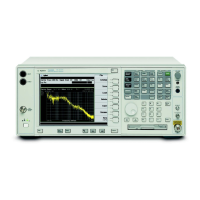Chapter 1 19
Overview
Before Troubleshooting a Failure
Before Troubleshooting a Failure
Before troubleshooting, complete the following three tasks:
1. Familiarize yourself with the safety symbols marked on the
instrument and read the safety information provided on page 2 of
this guide.
2. Read the ESD Information below.
3. Familiarize yourself with the troubleshooting information in the
Overall Troubleshooting chapter, and how it relates to information
on troubleshooting the RF, IF, Synthesizer, and Controller in this
guide.
ESD Information
Protection from Electrostatic Discharge
Electrostatic discharge (ESD) can damage or destroy electronic
components. All work on electronic assemblies should be performed at a
static-safe workstation. Figure 1-1 shows an example of a static-safe
workstation using two types of ESD protection:
❏ Conductive table-mat and wrist-strap combination.
❏ Conductive floor-mat and heel-strap combination.
Both types (when used together) provide a significant level of ESD
protection. Only the table-mat and wrist-strap combination provide
adequate ESD protection when used alone. To ensure user safety, the
static-safe accessories must provide at least 1 MΩ of isolation from
ground. Refer to Table 1-1 for information on ordering static-safe
accessories.
WARNING These techniques for a static-safe workstation should not be
used when working on circuitry with a voltage potential
greater than 500 volts.

